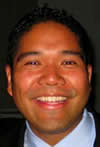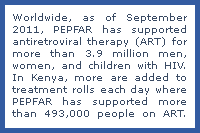Categories: Global Health, HIV/AIDS
February 17th, 2013 9:04 pm ET -
Edward Vallejo, ASPH/CDC Global Strategic Information Fellow
This is the first in our “Fresh Voices From the Field” series, where we hear from ASPH Global Health Fellows working throughout the world. Global Health Fellows are recent Master of Public Health or Doctoral graduates placed in CDC global health offices in Atlanta and abroad. They work on a range of priority public health issues and bring a fresh perspective to CDC’s efforts in the field.

Edward Vallejo, ASPH/CDC Global Strategic Information Fellow
Does having access to clean water, stable electricity, and freedom from the fear of contracting an infectious disease make your list of major health and safety concerns? If you live in the developed world, the answer is most likely no, but for the last four months, I have been working in the West African country of Nigeria, where those issues and an ever-changing security situation are a regular part of my daily life. As a member of CDC Nigeria’s Strategic Information Team, my focus has been on HIV/AIDS, the global pandemic that is a leading cause of death for the 170 million people living in Africa’s most populous country.
Less than a month after arriving, I helped to coordinate a large-scale HIV/AIDS service and data quality assessment that involved 40 public health physicians, epidemiologists, strategic information and database specialists traveling to 18 medical facilities across the country. These personnel from CDC Nigeria, CDC Atlanta, the University of California at San Francisco, Nigeria’s Federal Ministry of Health and the Nigerian Field Epidemiology and Laboratory Training Program developed a detailed picture of the current state of services and data in those facilities. As a result, established and future programs will benefit from our recommendations, especially in preventing mother to child transmission of HIV/AIDS, an area in which Nigeria carries a substantial burden.
Any misconceptions that I held about the importance and effectiveness of this work have been put to rest. Treating those ravaged by HIV/AIDS and preventing the further spread of this disease is absolutely necessary in order to stop millions more from suffering and dying needlessly. Despite the long, hard road ahead, the dedication of the Nigerian people and others around the world will make the creation of an AIDS-free generation a reality that we can all look forward to.
 Post a Comment -
Read more
Post a Comment -
Read more

Categories: Global Health, HIV/AIDS
February 11th, 2013 9:44 am ET -
Deborah Birx, MD
Director of Division of Global HIV/AIDS (DGHA)

Debbi Birx, MD
As we usher in the New Year, I am struck by the incredible gains made – especially in the last 12-24 months – in the fight against HIV/AIDS and the key role the United States has played. The U.S. President’s Emergency Plan for AIDS Relief (PEPFAR), under the leadership of the Office of the Global AIDS Coordinator (OGAC), has helped pave the way to historic progress. The U.S. Global AIDS Coordinator, Ambassador Eric Goosby, has strategically guided the implementation of PEPFAR by leveraging scientific advances, innovation, and the strengths of each PEPFAR implementing agency to ensure the greatest health impact.

Photo: David Snyder/CDC Foundation
Unprecedented results
This impact was confirmed in the UNAIDS 2012 global report. New HIV infection rates have fallen by 50% or more in 25 countries with an additional 14 countries having achieved incidence declines ranging from 25% to 49%. Half of all reductions in new HIV infections are among children, reflecting strong progress towards the elimination of mother-to-child transmission.
These unprecedented results also show increasing momentum over recent years as evidence-based, high-impact prevention interventions have been scaled-up. Importantly, the report also demonstrated that in a very small number of countries, stalling the expansion of HIV services can reverse hard won gains.
On the path to an AIDS-free generation

Photo: PEPFAR- Uganda
In November 2012, Secretary Clinton unveiled the PEPFAR Blueprint: Creating an AIDS-free Generation, and acknowledged we possess the tools to win the war against HIV/AIDS but must aggressively implement them to continue building momentum and avoid losing ground. Just one year ago, President Obama announced accelerated PEPFAR goals to achieve an AIDS-free generation. That call to action has resonated world-wide and has inspired us all to intensify and refocus our efforts.
A focus on proven interventions
Since then, under the leadership of OGAC, CDC has mobilized its resources in Atlanta and field offices around the world to meet these goals for antiretroviral treatment,  prevention of mother-to-child transmission, and voluntary medical male circumcision. Concurrently, HIV counseling and testing services are being ramped-up as the critical entry point for these interventions along with an intensified focus on reaching key populations at high-risk for HIV acquisition.
prevention of mother-to-child transmission, and voluntary medical male circumcision. Concurrently, HIV counseling and testing services are being ramped-up as the critical entry point for these interventions along with an intensified focus on reaching key populations at high-risk for HIV acquisition.
I am excited and invigorated at how far we’ve come and how far I know we can go. We have reached a historic moment – for the first time, we have the tools and leadership needed to win this fight.
 Post a Comment -
Read more
Post a Comment -
Read more

Categories: Global Health, HIV/AIDS, polio
February 1st, 2013 12:00 pm ET -
Tom Frieden, Director of CDC
 For more than 30 years, the US CDC has worked with China on public health issues that have benefited people of all nations. Together our nations proved the benefits of folic acid which saved children around the world from birth defects. We are exploring novel approaches to HIV prevention, testing and treatment. We are researching risk factors for cardiovascular disease – one of the world’s leading causes of death. Along with other nations, China and the US are working together on influenza surveillance to better protect the world.
For more than 30 years, the US CDC has worked with China on public health issues that have benefited people of all nations. Together our nations proved the benefits of folic acid which saved children around the world from birth defects. We are exploring novel approaches to HIV prevention, testing and treatment. We are researching risk factors for cardiovascular disease – one of the world’s leading causes of death. Along with other nations, China and the US are working together on influenza surveillance to better protect the world.
This week, I had an opportunity to discuss these achievements with my colleague Dr. Wang Yu, Director of the Chinese Center for Disease Control and Prevention (China CDC). The US CDC and China CDC Directors meet annually to decide our mutual priorities, explore ways to share what we’ve learned with other nations and expand upon our collaborative successes. This was the tenth anniversary of the US-China CDC Directors meeting that allowed for reflection on a few key 10-year benchmarks.
 Post a Comment -
Read more
Post a Comment -
Read more

Categories: Global Health, Malaria, Parasites
January 28th, 2013 12:48 pm ET -
Laurence Slutsker, MD, MPH
 Twenty five years ago, I went to western Kenya as a Centers for Disease Control and Prevention (CDC) Epidemic Intelligence Service (EIS) officer to study an outbreak of severe anemia. No one was sure of the cause. Was it parvovirus, or exposure to an environmental toxin, perhaps? In the hospital there were five or six sick children to a bed, and they were so anemic that their blood looked more like a pinkish fluid than the rich red to which we are accustomed. As it turned out, there was no exotic cause. I was seeing the ravages of drug-resistant malaria at a time when chloroquine, the routinely used antimalarial drug, was failing globally.
Twenty five years ago, I went to western Kenya as a Centers for Disease Control and Prevention (CDC) Epidemic Intelligence Service (EIS) officer to study an outbreak of severe anemia. No one was sure of the cause. Was it parvovirus, or exposure to an environmental toxin, perhaps? In the hospital there were five or six sick children to a bed, and they were so anemic that their blood looked more like a pinkish fluid than the rich red to which we are accustomed. As it turned out, there was no exotic cause. I was seeing the ravages of drug-resistant malaria at a time when chloroquine, the routinely used antimalarial drug, was failing globally.
That kind of grim hospital scene is much rarer these days, thanks to the enormous investment in malaria programs in Africa over the past decade and the improvements these investments have made possible. Programs that provide proven interventions—artemisinin-based combination therapies (ACTs), insecticide-treated bed nets (ITNs), and indoor residual spraying (IRS)—have achieved a 33% reduction in malaria deaths in the African region and 1.1 million lives saved globally. We have much more to do, but this is a reason to celebrate. As we celebrate, however, we must realize that we are also in the midst of a very fragile situation for three major reasons.
 Post a Comment -
Read more
Post a Comment -
Read more

Categories: Global Health, Health Systems Strengthening
December 27th, 2012 4:20 pm ET -
Elizabeth H Howze, ScD, CHES
 Season’s Greetings! As we come to the close of 2012 and embrace 2013, I wanted to reach out and let you know that CDC has reached an important milestone in training global health leaders. We’re celebrating the 20th Anniversary of the Sustainable Management Development Program (SMDP) — a program that CDC developed in 1992 to assist ministries of health in low- and middle-resource countries strengthen their health management systems.
Season’s Greetings! As we come to the close of 2012 and embrace 2013, I wanted to reach out and let you know that CDC has reached an important milestone in training global health leaders. We’re celebrating the 20th Anniversary of the Sustainable Management Development Program (SMDP) — a program that CDC developed in 1992 to assist ministries of health in low- and middle-resource countries strengthen their health management systems.
To kick-off the 20th Anniversary celebration, we hosted a webinar on December 11th and invited all of our graduates from the Global Health Leadership Forum (Forum) and the Management for Improved Public Health (MIPH) to join the webinar and share their experiences. I was so pleased to see that graduates from all over the world participated in the webinar and shared powerful stories about how the Forum and the MIPH program have been of value in helping them make sound decisions as they progressed in their careers.
 Post a Comment -
Read more
Post a Comment -
Read more

Categories: Children in Adversity, Global Health
December 19th, 2012 9:00 am ET -
Dr. Tom Frieden
 CDC welcomes the implementation of the U.S. Government Action Plan on Children in Adversity. At the heart of the Action Plan is the dedication to reducing violence against children, along with its vast, common, destructive and preventable consequences, including HIV, chronic diseases, and mental health problems. CDC is committed to working alongside other USG agencies and an array of global partners to help assure that children not only survive, but also thrive, growing up in strong families, with safe, stable and nurturing relationships. CDC’s work with Together for Girls, funded through the President’s Emergency Plan for AIDS Relief, is just one example of such partnerships.
CDC welcomes the implementation of the U.S. Government Action Plan on Children in Adversity. At the heart of the Action Plan is the dedication to reducing violence against children, along with its vast, common, destructive and preventable consequences, including HIV, chronic diseases, and mental health problems. CDC is committed to working alongside other USG agencies and an array of global partners to help assure that children not only survive, but also thrive, growing up in strong families, with safe, stable and nurturing relationships. CDC’s work with Together for Girls, funded through the President’s Emergency Plan for AIDS Relief, is just one example of such partnerships.
CDC’s uniquely valuable contribution to the Action Plan consists in linking nationally representative survey data on the magnitude and impact of violence against children to effective, sustainable, and scalable  programs that reduce violence and its consequences. The need for these Violence Against Children Surveys, which have been conducted in Swaziland, Kenya, Tanzania, Zimbabwe, and Haiti, is strong and growing. The data from these surveys increase countries’ abilities to create and evaluate violence prevention efforts and to help victims and their families.
programs that reduce violence and its consequences. The need for these Violence Against Children Surveys, which have been conducted in Swaziland, Kenya, Tanzania, Zimbabwe, and Haiti, is strong and growing. The data from these surveys increase countries’ abilities to create and evaluate violence prevention efforts and to help victims and their families.
CDC will continue to support the objectives of the Action plan through partnerships that help nations around the world invest effectively in the futures of their children.
Thomas R. Frieden, MD, MPH
Director, Centers for Disease Control and Prevention
 Post a Comment -
Read more
Post a Comment -
Read more

Categories: Global Health, Immunization, Kenya, polio
October 23rd, 2012 4:46 pm ET -

Victoria Gammino
The CDC “Nomads Project” was piloted in northern Nigeria in 2011 and brought to scale in 2012 through funding from USAID. The concept is now being piloted by CDC-Kenya in collaboration with CDC’s Global Immunization Division. In addition to bilateral government and NGO partners in Kenya and Nigeria, CDC collaborates with colleagues from WHO, UNICEF, and FAO as part of CDC’s effort to eradicate polio.
Health care systems are designed to meet the needs of the population in the communities where they exist, generally addressing the most urgent health needs, and providing services in a culturally familiar context. But what if that “community” is a mobile one? Many of the things we take for granted — continuity of care or even familiarity with the language and customs among health care providers — can vary from region to region.
 1 Comment -
Read more
1 Comment -
Read more

Categories: Global Health, HIV/AIDS
July 26th, 2012 12:01 pm ET -
Jane Mwangi, CDC Kenya
 This week, as scientists and public health partners meet at the International AIDS Society (AIDS 2012) meeting in Washington, D.C., one of the key challenges for the U.S. President’s Emergency Plan for AIDS Relief (PEPFAR) is to continue to increase the numbers of individuals on antiretroviral therapy (ART) while making sure that those who are currently on ART get quality care.
This week, as scientists and public health partners meet at the International AIDS Society (AIDS 2012) meeting in Washington, D.C., one of the key challenges for the U.S. President’s Emergency Plan for AIDS Relief (PEPFAR) is to continue to increase the numbers of individuals on antiretroviral therapy (ART) while making sure that those who are currently on ART get quality care.
 Increasing access to improved clinical management in resource-limited settings and identifying persons on ART whose treatment is beginning to fail is a key area where CDC, one of the key U.S. agencies implementing PEPFAR, brings its public health research and evaluation expertise to the table. Through research supported by PEPFAR, CDC in partnership with the Kenya Medical Research Institute (KEMRI) and the Kenya Ministry of Health and Sanitation will present at AIDS 2012 the results of three studies on viral load (VL) testing and illustrate how treatment access and outcomes can be improved.
Increasing access to improved clinical management in resource-limited settings and identifying persons on ART whose treatment is beginning to fail is a key area where CDC, one of the key U.S. agencies implementing PEPFAR, brings its public health research and evaluation expertise to the table. Through research supported by PEPFAR, CDC in partnership with the Kenya Medical Research Institute (KEMRI) and the Kenya Ministry of Health and Sanitation will present at AIDS 2012 the results of three studies on viral load (VL) testing and illustrate how treatment access and outcomes can be improved.
 Post a Comment -
Read more
Post a Comment -
Read more

Categories: Global Health, HIV/AIDS
July 23rd, 2012 10:02 pm ET -
John Blandford
 By any measure, the U.S. President’s Emergency Plan for AIDS Relief (PEPFAR) – in which CDC plays a key role – has proven to be a great success. Since its launch in 2003, PEPFAR has provided life-saving antiretroviral drug treatment for nearly 4 million people worldwide and last year alone provided care and support for nearly 13 million people and helped more than 200,000 infants to be born HIV-free. Still, millions more people are infected with the HIV virus ever year, many of them children.
By any measure, the U.S. President’s Emergency Plan for AIDS Relief (PEPFAR) – in which CDC plays a key role – has proven to be a great success. Since its launch in 2003, PEPFAR has provided life-saving antiretroviral drug treatment for nearly 4 million people worldwide and last year alone provided care and support for nearly 13 million people and helped more than 200,000 infants to be born HIV-free. Still, millions more people are infected with the HIV virus ever year, many of them children.
The bottom line? We need to work harder and smarter to take advantage of the new science for preventing HIV infections – all the more essential in the context of current global financial challenges. I am in Washington, DC this week at the International AIDS Society Conference to discuss how public health economics can contribute to achieving the goal of an AIDS-free generation.
 1 Comment -
Read more
1 Comment -
Read more

Categories: Child Survival, Child Survival Summit, Global Health, HIV/AIDS
June 14th, 2012 9:05 am ET -
Kevin De Cock, MD, FRCP (UK), DTM&H

Dr. Kevin De Cock, Director of Center for Global Health
Improvements in child health are a major focus of the health-related Millennium Development Goals (MDGs). Targets set for 2015 are rapidly approaching, and, much remains to be done to achieve reductions in child mortality. This week’s Child Survival Call to Action in Washington, DC (June 14-15) will address progress achieved and challenges ahead (www.apromiserenewed.org). International NGOs, representatives of US Government global health programs, and ministers of health from around the world will gather to discuss strategies to advance child survival goals.
CDC’s global health programs have contributed significantly to accomplishments related to child survival. The breadth and depth of CDC’s expertise in child health stems from both its domestic and global work. With CDC offices in over 40 countries, our strong partnerships with ministries of health are critical to achieve goals associated with child health.
 1 Comment -
Read more
1 Comment -
Read more

Categories: Global Health, Immunization
April 23rd, 2012 4:25 pm ET -
Dr. Kevin De Cock
Dr. Kevin De Cock is Director of the CDC Center for Global Health (CGH).
 Many voices join in the inspirational stories of global health. Today we begin sharing these stories through a new blog we call “Our Global Voices.” Check in often to hear and share in global health stories from around the world. We invite you to join the conversation on important global health topics. In this blog you’ll interact with CDC’s global health leaders and staff working to improve health and save lives around the world.
Many voices join in the inspirational stories of global health. Today we begin sharing these stories through a new blog we call “Our Global Voices.” Check in often to hear and share in global health stories from around the world. We invite you to join the conversation on important global health topics. In this blog you’ll interact with CDC’s global health leaders and staff working to improve health and save lives around the world.
We kick off our blog today with the first ever World Immunization Week, observed April 21-28, 2012. Immunization prevents between 2 and 3 million deaths every year worldwide. World Immunization Week is a global event sponsored by the World Health Organization to underscore the importance of immunization in saving lives and to encourage parents to vaccinate their children.
Let me share three reasons why immunization is so important to protecting children and for improving health for all of us.
Immunization works
If ever the term “breakthrough” applies to public health, it applies to immunization. Through this approach we have witnessed extraordinary progress against a host of infectious diseases that caused incalculable suffering and loss throughout most of human history. Today safe and effective vaccinations spare the lives of countless children, and at the same time protect parents and families. Diseases like diphtheria, pertussis, measles, rubella, and polio once swept through communities. Now, most people in developed countries never encounter anyone who’s had any one of these diseases because immunization works so well at preventing or even eradicating them. Some vaccines, like those against human papilloma virus and hepatitis B virus, for example, prevent later complications such as cancer of the liver and cervix, respectively.

Child receiving measles vaccine. Photo credit: C. McNab/Measles Initiative
Immunization is possible
CDC, the World Health Organization (WHO) and United Nations Children’s Fund (UNICEF) are helping countries assure that no fewer than nine out of ten children in every country receive the three-dose diphtheria-tetanus-pertussis (DTP3) vaccine by their first birthday. By 2009 coverage reached 82 percent. In January 2012, India marked its first anniversary without a single case of polio. Successful polio elimination in the world’s second largest country demonstrates, again, that immunization works and immunization is possible.
Immunization is right
The public health tradition upholds the ideal of social justice. We can attribute the virtual elimination of severe illness and death from childhood diseases in the world’s affluent countries to safe, effective vaccines. Immunization works; its safety and affordability make immunization possible everywhere. But just as measles progress has shown to be fragile in Europe when immunization uptake declines, so it is across much of Africa where weak programs lead to renewed outbreaks and deaths. Measles can then affect unvaccinated individuals and communities in the US. Our commitment to social justice obliges us to recognize that regardless of where they live, children and adults need not suffer from diseases we can and should prevent. That is the promise and moral obligation of immunization.
 3 Comments -
Read more
3 Comments -
Read more

Categories: Global Health, Immunization, World Immunization Week, vaccine
April 24th, 2012 7:24 pm ET -
Sara Test, MPH
CDC-Kenya, Nairobi, Kenya
 Recently I had the opportunity to speak with Tabu Collins, a Medical Epidemiologist for the Kenyan Ministry of Public Health and Sanitation (MOPHS). Tabu told me about his journey to becoming an epidemiologist and the public health challenges and successes in Kenya. Every day he sees the power of vaccines, not only to save but also to transform lives, giving children in Kenya an opportunity to grow up healthy, go to school, and live long productive lives.
Recently I had the opportunity to speak with Tabu Collins, a Medical Epidemiologist for the Kenyan Ministry of Public Health and Sanitation (MOPHS). Tabu told me about his journey to becoming an epidemiologist and the public health challenges and successes in Kenya. Every day he sees the power of vaccines, not only to save but also to transform lives, giving children in Kenya an opportunity to grow up healthy, go to school, and live long productive lives.
 2 Comments -
Read more
2 Comments -
Read more

Categories: Global Health, Immunization, World Immunization Week, measles, vaccine
April 27th, 2012 9:08 pm ET -
Jeffrey McFarland, MD
 In celebration of world immunization week, one cannot ignore the great strides China has made to protect over one-fifth of the world’s population from vaccine preventable diseases. The Chinese government has worked closely with CDC, WHO, UNICEF and other partners as it has addressed this challenge head on with new policies, supplemental immunization activities and successes reaching those most in need of care. These steps protect not only China’s population from disease, but also protect the U.S. and the rest of the world from the global spread of infectious, vaccine-preventable health threats.
In celebration of world immunization week, one cannot ignore the great strides China has made to protect over one-fifth of the world’s population from vaccine preventable diseases. The Chinese government has worked closely with CDC, WHO, UNICEF and other partners as it has addressed this challenge head on with new policies, supplemental immunization activities and successes reaching those most in need of care. These steps protect not only China’s population from disease, but also protect the U.S. and the rest of the world from the global spread of infectious, vaccine-preventable health threats.
 5 Comments -
Read more
5 Comments -
Read more

Categories: Global Health, Malaria
May 9th, 2012 5:17 pm ET -
Mary Hamel, MD, MPH
 Tens of thousands of children’s lives have been saved in Africa, largely thanks to the rapid scale-up of four safe, effective malaria interventions―made possible by dramatically increased funding starting in the early 2000s.
Tens of thousands of children’s lives have been saved in Africa, largely thanks to the rapid scale-up of four safe, effective malaria interventions―made possible by dramatically increased funding starting in the early 2000s.
Still, too many children are dying―about one every minute―and the fight against malaria is far from over. Worldwide an estimated 655,000 people died of malaria in 2010. Most of them were young children in Africa.
The global malaria community no longer articulates “control” as the goal. The goals are now elimination in individual countries and eventually global eradication.
 1 Comment -
Read more
1 Comment -
Read more

Categories: Chagas, Global Health, Parasites
June 5th, 2012 2:18 pm ET -
By Dr. Susan Montgomery, DVM, MPH

Dr. Susan Montgomery, DVM, MPH
From its labs in Atlanta and around the world, Centers for Disease Control and Prevention scientists have been dissecting insects and the parasites they leave in humans for more than 65 years. The kissing bug, also known as a triatomine, can be infected by Trypanosoma cruzi, the parasite that causes Chagas disease. It is not widespread in the United States, but 300,000 people are infected by Trypanosoma cruzi and have Chagas disease.
Chagas can cause cardiac disease including stroke and arrhythmias, and gastrointestinal disease over time. It can take several years to decades for the infection to take its toll on the human heart and stomach.
 1 Comment -
Read more
1 Comment -
Read more


















 Recently I had the opportunity to speak with Tabu Collins, a Medical Epidemiologist for the Kenyan Ministry of Public Health and Sanitation (MOPHS). Tabu told me about his journey to becoming an epidemiologist and the public health challenges and successes in Kenya. Every day he sees the power of vaccines, not only to save but also to transform lives, giving children in Kenya an opportunity to grow up healthy, go to school, and live long productive lives.
Recently I had the opportunity to speak with Tabu Collins, a Medical Epidemiologist for the Kenyan Ministry of Public Health and Sanitation (MOPHS). Tabu told me about his journey to becoming an epidemiologist and the public health challenges and successes in Kenya. Every day he sees the power of vaccines, not only to save but also to transform lives, giving children in Kenya an opportunity to grow up healthy, go to school, and live long productive lives.



